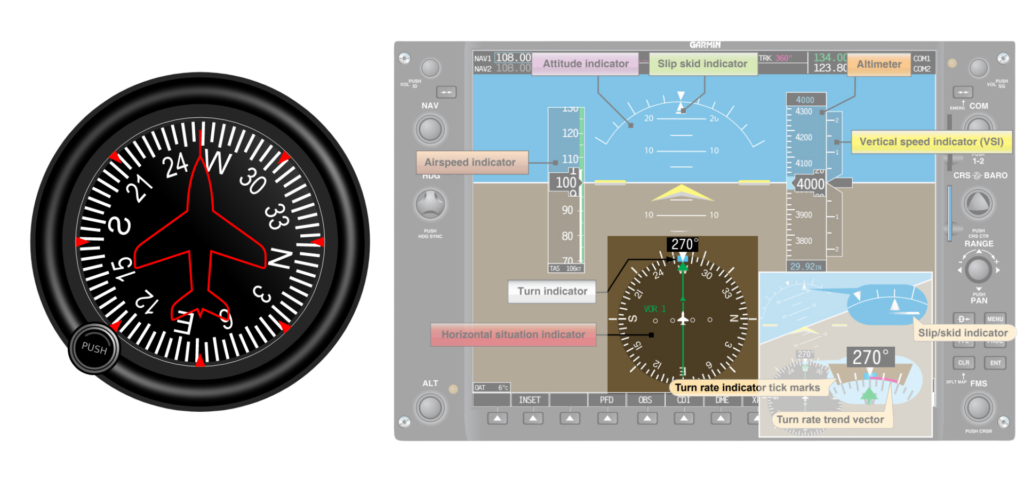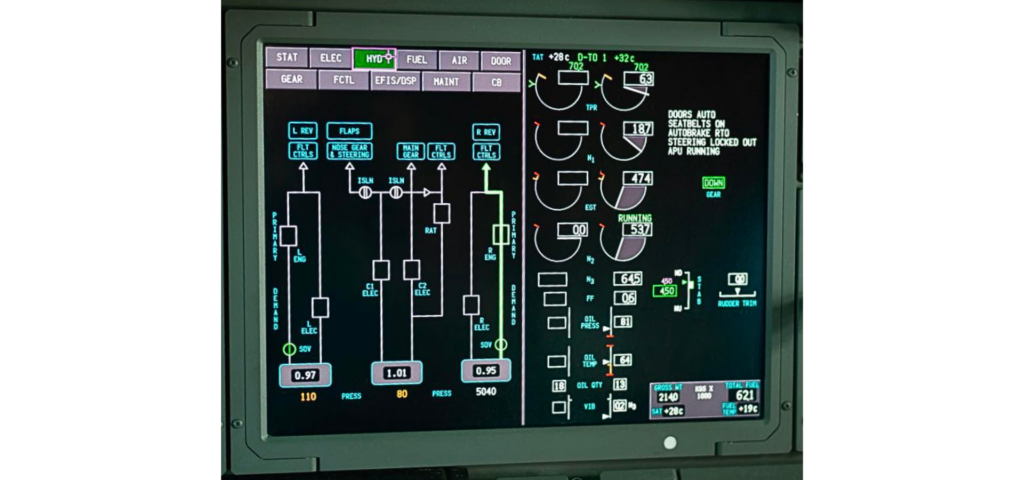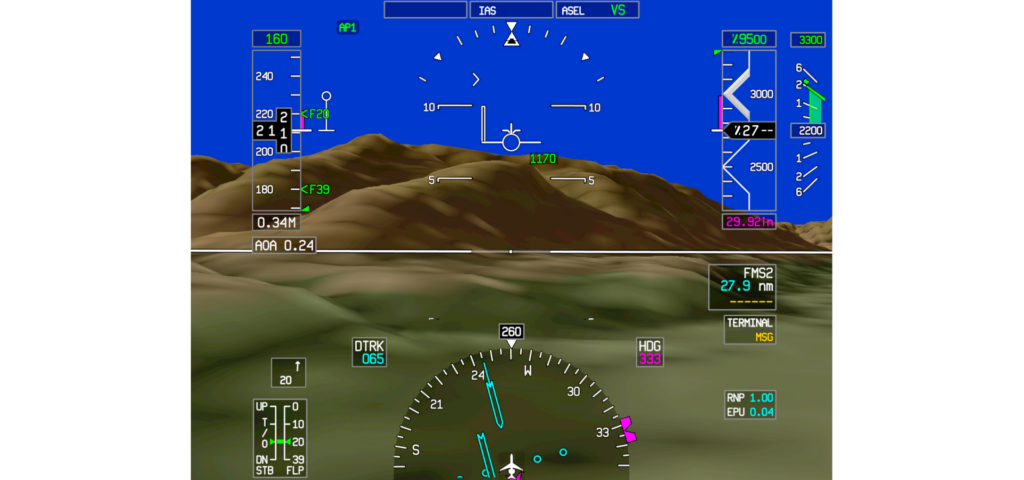-
A Brief History of Flight Instruments
-
Types of Flight Instruments
-
Primary Flight Instruments
- Attitude Indicator (AI) / Artificial Horizon (AH)
- Airspeed Indicator (ASI)
- Altimeter
- Vertical Speed Indicator (VSI)
- Heading Indicator (HI) / Direction Indicator (DI)
- Turn Coordinator
-
Secondary Flight Instruments
- Horizontal Situation Indicator (HSI)
- Course Deviation Indicator (CDI)
- Radar Altimeter
- Distance Measuring Equipment
- The angle of Attack Indicator (AoA)
- Outside Air Temperature (OAT)
-
The Modern Glass Cockpit
- Primary Flight Display (PFD)
- Multi-Function Display (MFD)
- Engine Indicating and Crew Alerting System (EICAS)
- Synthetic Vision System (SVS)
-
The Future of Flight Instruments
-
Conclusion
Airplanes are amongst the most complex pieces of machinery on the entire planet. Since they are navigating an ever-changing environment in the sky, it makes sense that they would require incredible technology.
Airplanes require a lot of skill and knowledge to operate safely. And while pilots receive extensive training to handle various situations, the flight instruments provide the crucial information they need to accomplish this difficult task.
With technology advancing at an astonishing pace, flight instruments are becoming more sophisticated and reliable than ever before. Today’s flight instruments offer unprecedented accuracy and functionality.
In this article, we’ll dive into the instruments pilots use every day to execute their missions. From the classic primary instruments developed in the 1930s (and still used today) to future Augmented Reality (AR) systems, we’ve compiled everything you need to know.
A Brief History of Flight Instruments
Before the 1930s, pilots used basic instruments like airspeed indicators, altimeters, and compasses. The 1903 Wright brothers’ flight featured a stopwatch and an anemometer to measure wind speed – not exactly a wealth of information to fly with, but enough for the time.
The late 1920s saw the adoption of gyroscopic flight instruments, with attitude and heading indicators introduced in the early 1930s. These allowed pilots to fly “blind,” navigating solely by instruments.

The Automatic Direction Finder (ADF) and VHF Omnidirectional Range (VOR) emerged (and became very popular) between the 1920s and 1950s, enabling pilots to navigate using radio signals from ground-based beacons.
Then, the modern age of avionics began. In the 1980s, digital displays were introduced, replacing analog gauges and ushering in a new world of avionics.
Since then, various developments have made flight instruments more versatile and easier to understand (more on that later).
Types of Flight Instruments
Nowadays, aircraft have become so complex that there is a separation between the flight instruments necessary for a safe flight and secondary instruments that simply add to the safety of the flight.
Let’s dive into the primary and secondary instruments and look at how they work.
Primary Flight Instruments
The primary flight instruments are those that are most necessary. They provide immediate information used to ensure that you are flying safely and the aircraft is operating normally.
Think of the primary flight instruments as the ones you would most hate to lose.
Attitude Indicator (AI) / Artificial Horizon (AH)

First, let’s talk about one of the most important flight instruments: the Attitude Indicator (AI), also known as the Artificial Horizon (AH).
The Attitude Indicator shows the aircraft’s pitch and bank, which are crucial for maintaining the desired altitude and heading. This instrument is especially important during instrument flight when the pilot cannot see the horizon due to poor weather conditions.
The AH is a miniature replica of the horizon, allowing the pilot to orient themselves and adjust the aircraft’s attitude.
Airspeed Indicator (ASI)

Next up is the Airspeed Indicator (ASI), which shows the aircraft’s current speed through the air. This is important for maintaining a safe speed during takeoff, landing, and flight in general.
The airspeed indicator is typically marked in knots and, less commonly, kilometers or miles per hour.
The airspeed indicator is a crucial instrument because maintaining the correct airspeed is extremely important. If an aircraft gets too slow, the wings won’t generate enough lift, and the aircraft will stall. If an aircraft goes too fast, it may damage the aircraft’s structure.
Altimeter

The altimeter is another important flight instrument. It shows the aircraft’s current altitude. In essence, an altimeter simply shows how high the airplane is.
Pilots need to maintain a safe altitude during flight, especially in areas with mountains or other obstacles.
The altimeter is usually marked in feet. Some countries, like Russia and China, use meters.
Vertical Speed Indicator (VSI)

The Vertical Speed Indicator (VSI), also known as the rate-of-climb indicator, shows the aircraft’s rate of climb (going up) or rate of descent (going down) in feet per minute.
This instrument is important for changing altitude at a steady pace. The VSI is typically marked in hundreds of feet per minute.
Heading Indicator (HI) / Direction Indicator (DI)

The Heading Indicator (HI), also known as the Direction Indicator (DI) and, less commonly, the Directional Gyro (DG), shows the aircraft’s current heading in degrees.
Pilots must maintain a steady heading during flight, especially when navigating busy airspace or following specific flight paths.
This instrument becomes more critical the further you fly in one direction. A single degree doesn’t make much difference when flying 20 miles. But when you’re flying across the country, it becomes vital.
Turn Coordinator

The turn coordinator is a flight instrument that shows how quickly your airplane is turning. It has a spinning device (gyroscope) that detects movement and a ball inside a curved tube that measures the smoothness of your turn.
When your airplane turns, the gyroscope moves, making the miniature aircraft symbol move according to how quickly you are turning. This information helps you keep your turns the same every time and prevents sliding or slipping – leading to safer, more efficient flying. Focus on keeping the ball centered during turns (using the rudder) for optimal coordination.
That concludes the six flight instruments that make up the primary flight instruments.
But don’t worry – there’s more! Let’s dive into the secondary flight instruments.
Secondary Flight Instruments
Secondary flight instruments are any instruments other than the six primary instruments. Their main function is to increase situational awareness. That is, making the pilot more aware of their surroundings to ensure the flight is as safe as possible.
Horizontal Situation Indicator (HSI)

Kicking things off, the Horizontal Situation Indicator (HSI) combines the heading indicator (HI) and the Course Deviation Indicator (CDI), into one instrument.
The HSI provides critical navigation information, showing the aircraft’s current heading and the desired course. The integrated CDI provides information about the aircraft’s position relative to the desired course, displaying any deviation left or right of the course line.
With this instrument, pilots can make minor corrections to stay on course, especially during instrument approaches and departures. Some HSI instruments incorporate a glide slope indicator, which provides vertical guidance during instrument approaches.

Course Deviation Indicator (CDI)

The CDI started as a standalone instrument but is integrated into the HSI on modern aircraft.
The CDI is used with a VOR, ILS, or GPS navigation system. It displays your position relative to the desired course, so you can make corrections and stay on track.
The CDI has a needle, which moves left or right depending on your position. If the needle is centered, you’re on course. If it’s to the left, you’re to the right of the course and need to turn left to correct. The needle’s deflection indicates how far off course you are.
Radar Altimeter
Next, we have the radar altimeter, which uses radio waves to measure the distance between the aircraft and the ground.
The radar altimeter is critical during landing, as it gives the pilot an accurate reading of the aircraft’s height above the ground, even when visibility is low.
Distance Measuring Equipment
Distance Measuring Equipment (DME) is another secondary instrument that provides pilots with distance information between the aircraft and ground-based navigation aid.
DME is normally used with VORs to provide distance information to a waypoint, allowing pilots to navigate to their destination accurately.
Charles Lindbergh would have loved to have one of these on the Spirit of St. Louis!
The angle of Attack Indicator (AoA)

The Angle of Attack Indicator (AoA) is an essential instrument for all pilots, providing critical information about the aircraft’s angle of attack.
This instrument can help pilots avoid stalls, which can be deadly, especially during takeoff and landing.
The AoA indicator provides a visual indication of the aircraft’s angle of attack, allowing pilots to adjust their pitch to avoid a stall. This instrument is especially useful for pilots flying aircraft without automatic stall protection systems, as a stall is one of the leading causes of aviation crashes.
Outside Air Temperature (OAT)
Lastly, we have the Outside Air Temperature (OAT) gauge, which provides the pilot with the Outside Air Temperature (OAT).
While this instrument may seem unimportant, the OAT gauge is used to calculate essential performance factors such as fuel consumption. More commonly, the OAT helps determine the risk of icing, which can be catastrophic during flight.
The added benefits of secondary instruments are numerous. It doesn’t take much to see how helpful adding these to any aircraft can be.
But how do these instruments look on the flight decks of today?
Most are found in glass cockpits.
The Modern Glass Cockpit
So, what exactly is a glass cockpit?
Simply put, it’s an aircraft cockpit that replaces traditional analog gauges with digital displays. Instead of relying on mechanical instruments to monitor the aircraft’s vital signs, pilots can now rely on computer screens that provide real-time data on everything from engine performance to weather conditions.
The technical term for glass cockpits is “Electronic Flight Instrument Systems” (EFIS). They are a complete game-changer for aviation safety. EFIS-equipped cockpits provide pilots with a wealth of information clearly and concisely. Instead of having to interpret analog gauges, pilots can quickly and easily read digital displays that show them everything they need to know about the aircraft’s performance.
On top of that, they’re entirely customizable. Pilots can choose which information they want to see on their screens and can even create custom displays. Pilots can tailor their cockpit to their specific needs and preferences, which can be especially important during complex or high-pressure situations.
Primary Flight Display (PFD)

If you’re a pilot, you know that the Primary Flight Display (PFD) is one of the most essential tools you have in the cockpit.
The PFD is a digital display typically located in front of the pilot. It shows the aircraft’s attitude, airspeed, altitude, vertical speed, and heading. Some PFDs also display additional information, such as navigation data, weather, and autopilot information.
Multi-Function Display (MFD)
At the center of the technological revolution in aviation is the Multi-Function Display (MFD). The MFD is essentially a computer screen that provides a wealth of information to the pilot. It’s an all-in-one display that displays additional information beyond what is on the PFD.
Essentially, anything that the pilot needs to know can be displayed on the MFD. You’ll often find navigation information on an MFD, such as a moving map.
The MFD sets itself apart by having complete customizability. Most MFDs can display engine information, traffic, weather, and even charts or checklists.
Engine Indicating and Crew Alerting System (EICAS)

EICAS is a system that monitors and displays the status of all critical systems in the aircraft, including the engines, hydraulics, fuel, and electrical systems.
In a glass cockpit, this information is displayed on a high-resolution screen, which provides pilots with a wealth of data in a clear, concise format. This means that pilots can quickly and easily identify any issues that may arise and take appropriate action to resolve them.
But EICAS isn’t just about displaying information – it’s also about alerting pilots to potential issues before they become critical. For example, if there’s an engine problem, the EICAS will display an alert to the pilots, along with information on the severity of the issue and any recommended actions. This means that pilots can take action before the problem becomes a significant safety issue.
Most aircraft manufacturers have their own version of an EICAS and use different acronyms to describe them. For example, Airbus calls its EICAS the Electronic Centralized Aircraft Monitor (ECAM).
Synthetic Vision System (SVS)

The Synthetic Vision System (SVS) is a game-changer for pilots. It’s a system that uses advanced computer graphics to generate a 3D image of the terrain, obstacles, and other essential features that a pilot needs to be aware of during a flight. This information is overlaid onto the pilot’s PFD, giving them an unparalleled view of their surroundings.
SVS gives pilots a clearer picture of their surroundings, even in poor visibility. For example, if a pilot is flying through thick clouds or fog, the SVS can display the terrain and runway as a 3D image, allowing the pilot to fly with greater confidence and safety.
The Future of Flight Instruments
Although these technologies are incredible, the future of flight instruments is brighter than ever. Humanity constantly pushes forward.
There are even more unbelievable technological advances in the works.
Augmented Reality (AR) systems are already used in high-end military aircraft, and these technologies are likely to reach the civilian market, too.
The rise of Artificial Intelligence (AI) will also impact aviation in ways we cannot even imagine. With AI and AR combined, the flight instruments used by future pilots (or autopilots) may look significantly different from what we use today.
One thing is for sure: Aviation is entering a whole new generation.
Conclusion
From altitude and airspeed to heading and fuel levels, flight instruments offer a wealth of real-time data that help pilots make informed decisions. They are the eyes and ears of the aircraft, allowing pilots to maintain situational awareness and make adjustments as needed.
Flight instruments are still only as good as the pilots who use them. That’s why it’s important for pilots to receive ongoing training and to stay up-to-date with the latest technologies and techniques. Because technology makes information more available, the way the pilot receives and responds to that information guarantees the flight’s safety.



